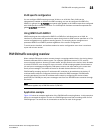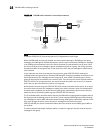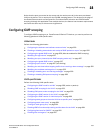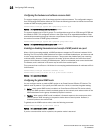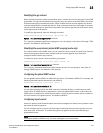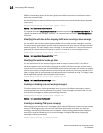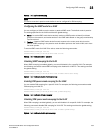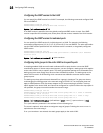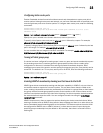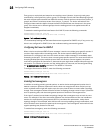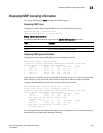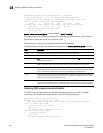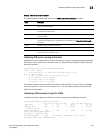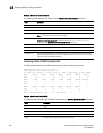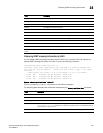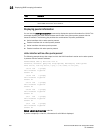
PowerConnect B-Series FCX Configuration Guide 661
53-1002266-01
Configuring IGMP snooping
22
Configuring static router ports
FastIron Stackable devices forward all multicast control and data packets to router ports which
receive queries. Although router ports are learned, you can force multicast traffic to specified ports
even though these ports never receive queries. To configure static router ports, enter the following
commands.
PowerConnect(config)# vlan 70
PowerConnect(config-vlan-70)# multicast router-port ethernet 0/1/4 to 0/1/5
ethernet 0/1/8
Syntax: [no] multicast router-port ethernet <port> [ethernet <port> | to <port>]
Specify the <port> variable in the format <stack-unit/slotnum/portnum>.
To specify a list of ports, enter each port as ethernet <port> followed by a space. For example,
ethernet 0/1/4 ethernet 0/1/5 ethernet 0/1/8
To specify a range of ports, enter the first port in the range as ethernet <port> followed by the last
port in the range. For example, ethernet 0/1/1 to 0/1/8.
You can combine lists and ranges in the same command. For example: enable ethernet 0/1/1 to
0/1/8 ethernet 0/1/24 ethernet 0/2/2 ethernet 0/2/4.
Turning off static group proxy
If a device has been configured for static groups, it acts as a proxy and sends membership reports
for the static groups when it receives general or group-specific queries. When a static group
configuration is removed, it is deleted from active group table immediately. However, leave
messages are not sent to the querier, and the querier must age the group out. Proxy activity can be
turned off. The default is on. To turn proxy activity off for VLAN 20, enter the following commands.
PowerConnect(config)# vlan 20
PowerConnect(config-vlan-20)# multicast proxy-off
Syntax: [no] multicast proxy-off
Enabling IGMPv3 membership tracking and fast leave for the VLAN
IGMPv3 gives clients membership tracking and fast leave capability. In IGMPv2, only one client on
an interface needs to respond to a router's queries. This can leave some clients invisible to the
router, making it impossible to track the membership of all clients in a group. When a client leaves
the group, the device sends group-specific queries to the interface to see if other clients on that
interface need the data stream of the client who is leaving. If no client responds, the device waits a
few seconds before it stops the traffic. You can configure the wait time using the ip multicast
leave-wait-time command.
IGMPv3 requires every client to respond to queries, allowing the device to track all clients. When
tracking is enabled, and an IGMPv3 client sends a leave message and there is no other client, the
device immediately stops forwarding traffic to the interface. This feature requires the entire VLAN
be configured for IGMPv3 with no IGMPv2 clients. If a client does not send a report during the
specified group membership time (the default is 140 seconds), that client is removed from the
tracking list.



